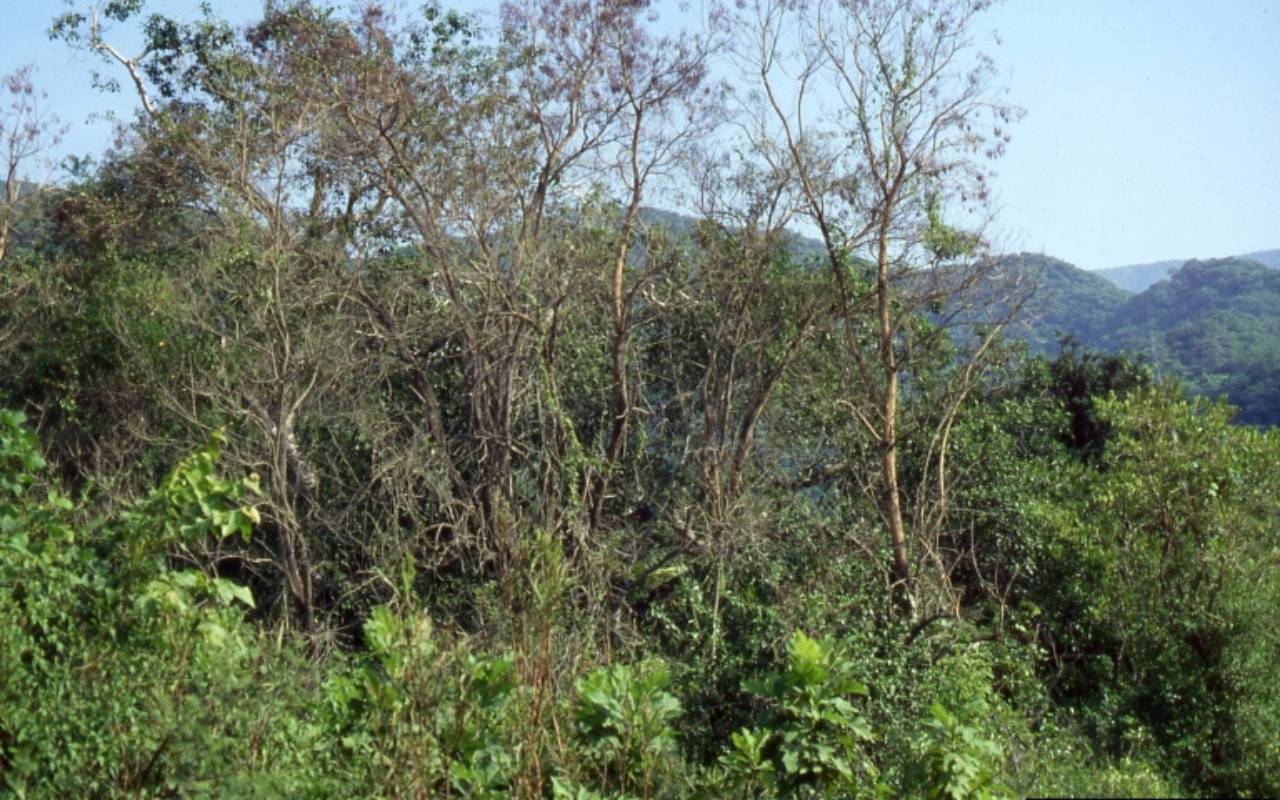Like trees everywhere, the trees in Northern Virginia are the targets of many tree diseases. While it’s often easy to tell if something is wrong with your tree due to browning leaves or premature leaf drop, knowing precisely what is making it sick is the first step in fighting and preventing Virginia tree diseases.
To help Northern Virginia tree lovers identify, manage, and prevent tree ailments, we’ve compiled a list of three common tree diseases you might face. These include:
- Anthracnose
- Oak Decline
- Armillaria Root Rot
Read on to learn more about the symptoms, causes, prevention, and treatment of these common tree conditions.

Anthracnose
Anthracnose is a broad term for a collection of fungal diseases that can infect your trees. Specifically, anthracnose is caused when fungi produce spores that can infect leaves, flowers, fruit, and stem tissues causing leaf drop and cankers on stems. These fungi can infect various tree parts, including leaves, flowers, fruits, and stem tissues.
Northern Virginia Trees Affected by Anthracnose
Anthracnose primarily infects common Virginia hardwoods, including:
- Sycamore
- Dogwood
- Oak
- Maple
- Ash
- Walnut
If you have trees, chances are you have at least one of these species on your property. So how can you identify anthracnose?
How to Identify Anthracnose
Depending on the specific type of anthracnose infecting your tree, symptoms of the condition will vary. The following symptoms in your trees can be a sign of anthracnose:
- Leaf spotting
- Blighting and shriveling of leaves
- Brown papery lesions on leaves
- Purple or brown streaks on leaves
- Significant, premature leaf drop
Treating and Preventing Anthracnose
Anthracnose diseases are generally considered a “cosmetic” or “nuisance” problem. This means your trees are not at risk of imminent death, but their aesthetics are compromised by spotting, blight, streaking, and browning.
Additionally, affected trees can drop many leaves prematurely, leaving them with thin canopies.
Fortunately, anthracnose rarely rises to a level requiring chemical control and can be managed through efficient cultural and sanitary practices. You can manage and prevent anthracnose by doing the following:
- Prune and remove visible cankers and affected twigs. Also, rake and remove fallen leaves. Anthracnose fungi overwinter in these structures. Removing them means less chance of infection the following year.
- Follow best culture practices through proper watering, fertilizing, mulching, and pruning. Healthy, well-maintained trees are better equipped to fight anthracnose.
While chemical interventions are not often necessary, anthracnose-infected saplings are at greater risk of death than established trees. Treat affected saplings with Mancozeb, a fungicide approved for homeowner use in Virginia.

Oak Decline
In recent years, chestnut and white oaks have been dying in high numbers. While initially thought to be caused by a specific fungal disease called “oak-wilt,” Fairfax County experts have reassessed the situation and believe oak deaths are due to a variety of factors all contributing to a condition called “oak decline”.
Signs of Oak Decline
Oak decline can be identified by the following symptoms:
- Progressive dying back from branch tips
- Thin foliage
- Sprout development on main branches or stems
- Premature browning and leaf drop
The Causes of Oak Decline
The factors that cause oak decline can be split into three groups: factors that are out of your control, factors you can remedy, and pest and disease factors.
Factors of Oak Decline That Are Out of Your Control
- Climatic trends
- Soil variables such as depth, texture, and fertility
- Genetics
- Age of the tree
Oak Decline Factors You Can Remedy
- Water stress
- Defoliating insects
- Root damage
Pest & Disease Factors of Oak Decline
- Boring insects
- Canker fungi
- Root disease
Though some factors of oak decline are out of your control, there are things you can do to remedy others, which should, in turn, discourage the pest and disease factors from contributing to the decline of your oaks.
What You Can Do to Decrease the Risk of Oak Decline in Your Trees
- Water your trees – especially during dry spells
- Avoid damaging trees – be careful during digging and construction
- Increase your tree’s space – consider removing encroaching lawns
- Avoid chemical treatments unless absolutely necessary
By adopting these good cultural practices, your trees can stay healthy and display natural resistance to contributing factors like disease and pest infestations. Experts also recommend talking to a professional tree service to help you assess issues with your oaks to determine the cause and the best course of action.

Armillaria Root Rot
Armillaria root rot is the general term for a group of diseases caused by fungi within the genus Armillaria. Sometimes called “shoestring rot,” due to the stringy black growth on infected trees, the disease attacks hardwoods and conifers throughout Northern Virginia.
Armillaria is considered a vital wood decomposer when its growth is limited to dead woody material. However, it becomes a significant problem when the fungus attacks living tree tissues.
Root rot is spread to nearby trees through the infected roots.
Northern Virginia Trees Affected by Armillaria Root Rot
Several Northern Virginia trees are known to be susceptible to armillaria root rot, including several fruit species grown in Virginia. These include:
- Oak
- Peach
- Apple
- Cherimoya
How to Identify Armillaria Root Rot
The key indicator for armillaria root rot is the growth of light brown mushrooms at the base of an infected tree during the wet fall and winter. Though they’re also called “honey mushrooms,” this name is due to the color, not the flavor. Honey mushrooms are edible; however, this is little consolation if you have an infected tree.
Additional signs of this disease include:
- Yellowing foliage
- Premature leaf drop
- Dieback of upper limbs
One sign of Armillaria root rot is the thin, flat, white fan-shaped sheets of fungal tissue (mycelial fans) that grow just below the bark.
To find these mycelial fans, select a dead or dying plant to examine. Dig into the soil at the base of the trunk and down to approximately 12 to 18 inches beneath the soil line. From the trunk and any large roots branching off the trunk, peel or cut away the dead bark with a knife to reveal mycelial fans and rotted wood.
The presence of black strings of fungal tissue (rhizomorphs) is another sign of infection. These strings of tissue may be found under the bark alongside the white mycelium. You can find these on infected roots or soil adjacent to the infected tree.
Rhizomorphs can be challenging to distinguish from fine roots but generally are darker, smoother, and lack the woody inner layer of plant roots. Since rhizomorphs and mushrooms are sometimes absent, and the mycelial fans are hidden under the bark, the presence of this fungus is often first revealed by symptoms on the trunk or in the canopy.
Treating and Preventing Armillaria Root Rot
There is no known chemical control for armillaria root rot. However, it is possible to manage the spread of the disease by removing infected root material and adhering to sound cultural practices.
Oversaturated or overly compacted soil can lead to a lack of oxygen uptake in the roots, a condition called hypoxia. In addition to creating poor conditions for root growth, hypoxia creates an ideal environment for armillaria root rot to develop.
Additional Things You Can Do to Prevent Armillaria
- Don’t plant in landscapes where trees have died from Armillaria root rot
- Avoid damaging roots
- Aerate soil to reduce compaction
- Prevent waterlogging soils around trees – especially in warm months
Lastly, root flares (or root collars) covered with soil are more susceptible to Armillaria root rot. It may be effective to excavate these flares with hand tools; however, this can create more problems by disturbing infected soil. For this reason, we recommend you consult a professional to see if this intervention is appropriate.
A better, preventative solution is to ensure root flares are not covered with soil when planting new trees.
Need Some Help with Northern Virginia Tree Diseases?
Is something strange happening with your trees? Do you need help identifying a specific tree problem? Have an unidentified pest attacked your trees? Green Vista offers tree care consultations. Let our tree professionals assess your trees and recommend the appropriate services to keep your trees healthy!
Give us a call at 571-244-3838, or request a quote online!
Get helpful tips, local news, inspiring stories, and more delivered right to your inbox every month. Don't miss another issue - join today!





